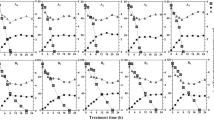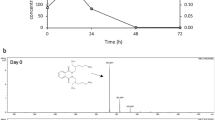Abstract
Objective
To enhance the biodesulfurization rate using a kinetic model that directs the ratio of Dsz enzymes.
Results
This study established a kinetic model that predicted the optimal ratio of Dsz enzymes in the 4S biodesulfurization system to be A:B:C = 1:2:4 and 1:4:2. When BCAD+1A+4B+2C, the conversion rate of dibenzothiophene (DBT) to 2-hydroxybiphenyl (HBP) was close to 100% in vitro. When the gene dose of dszC was increased, the HBP yield of the recombinant strain BL21(DE3)/BCAD + C reached approximately 0.012 mM in vivo, which was approximately 6-fold higher than that of the BCAD strain.
Conclusions
According to the results predicted by the enzyme kinetic model, maintaining higher concentrations of DszC and DszB in the desulfurization system can effectively improve the desulfurization efficiency.





Similar content being viewed by others
Abbreviations
- HDS:
-
Hydrodesulfurization
- BDS:
-
Biodesulfurization
- DBT:
-
Dibenzothiophene
- HBP:
-
2-Hydroxybiphenyl
- DBTO2 :
-
Dibenzothiophene sulfone
- HBPS:
-
2-(2-Hydroxybiphenyl) 2 sulfinic acid salt
- HPLC:
-
High-performance liquid chromatography
References
Abinfuentes A, Mohamed ES, Wang DIC, Prather KLJ (2013) Exploring the mechanism of biocatalyst inhibition in microbial desulfurization. Appl Environ Microbiol 79:7807–7817
Agarwal M, Dikshit PK, Bhasarkar JB, Borah AJ, Moholkar VS (2016) Physical insight into ultrasound-assisted biodesulfurization using free and immobilized cells of Rhodococcus rhodochrous MTCC 3552. Chem Eng J 295:254–267
Calzada J, Heras S, Alcon A, Santos VE, Garciaochoa F (2009) Biodesulfurization of dibenzothiophene (DBT) using Pseudomonas putida CECT 5279: a biocatalyst formulation comparison. Energy Fuels 23:155–166
Dejaloud A, Vahabzadeh F, Habibi A (2017) Ralstonia eutropha as a biocatalyst for desulfurization of dibenzothiophene. Bioprocess Biosyst Eng 40:1–12
Denome SA, Olson ES, Young KD (1993) Identification and cloning of genes involved in specific desulfurization of dibenzothiophene by Rhodococcus sp. strain IGTS8. Appl Environ Microbiol 59:2837–2843
Ferreira P, Sousa SF, Fernandes PA, Ramos MJ (2017) Improving the catalytic power of the DszD enzyme for the biodesulfurization of crude oil and derivatives. Chemistry 23:17231–17241
Galán B, Díaz E, García JL (2000) Enhancing desulphurization by engineering a flavin reductase-encoding gene cassette in recombinant biocatalysts. Environ Microbiol 2:687–694
Gumpf JJ, Idrizi K, Watkins L (2017) Expression, purification, and characterization of codon optimized and mutant variations of DszB from N. asteroides. FASEB J 31:764–767
Li L et al (2019) Improved efficiency of the desulfurization of oil sulfur compounds in Escherichia coli using a combination of desensitization engineering and DszC overexpression. ACS Synth Biol 8:1441–1451
Martínez I, Mohamed ES, Rozas D, García JL, Díaz E (2016) Engineering synthetic bacterial consortia for enhanced desulfurization and revalorization of oil sulfur compounds. Metab Eng 35:46
Martínez I, Elsaid MM, Santos VE, García JL, Garcíaochoa F, Díaz E (2017) Metabolic and process engineering for biodesulfurization in gram-negative bacteria. J Biotechnol 262:47–55
Rollin JA et al (2015) High-yield hydrogen production from biomass by in vitro metabolic engineering: mixed sugars coutilization and kinetic modeling. Proc Natl Acad Sci USA 112:4964–4969
Santos VE, AlcãN A, MartãN AB, GãMez E, Garcia-Ochoa F, (2007) Desulfurization of dibenzothiophene using the 4S enzymatic route: influence of operational conditions on initial reaction rates. Biocatalysis 25:286–294
Yu Y, Fursule IA, Mills LC, Englert DL, Berron BJ, Payne CM (2017) CHARMM force field parameters for 2′-hydroxybiphenyl-2-sulfinate, 2-hydroxybiphenyl, and related analogs. J Mol Graph Model 72:32–42
Supporting information
Supplementary Figure 1. The rate of conversion of DBT to HBP by BL21(DE3)/BADC+C.
Funding
This research was financially supported by the National Natural Science Foundation of China (Grant No. 31470159), the National Science Foundation for Young Scientists of China (Grant No. 31400062).
Author information
Authors and Affiliations
Corresponding authors
Ethics declarations
Conflict of interest
The authors declare no competing financial interest.
Ethical approval
This article does not contain any studies with human participants or animals performed by any of the authors.
Informed consent
Informed consent was obtained from all individual participants included in the study.
Additional information
Publisher's Note
Springer Nature remains neutral with regard to jurisdictional claims in published maps and institutional affiliations.
Electronic supplementary material
Below is the link to the electronic supplementary material.
Rights and permissions
About this article
Cite this article
Li, L., Ye, L., Guo, Z. et al. A kinetic model to optimize and direct the dose ratio of Dsz enzymes in the 4S desulfurization pathway in vitro and in vivo. Biotechnol Lett 41, 1333–1341 (2019). https://doi.org/10.1007/s10529-019-02730-1
Received:
Accepted:
Published:
Issue Date:
DOI: https://doi.org/10.1007/s10529-019-02730-1




